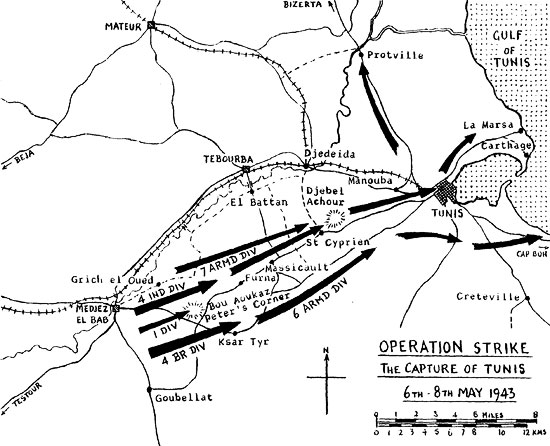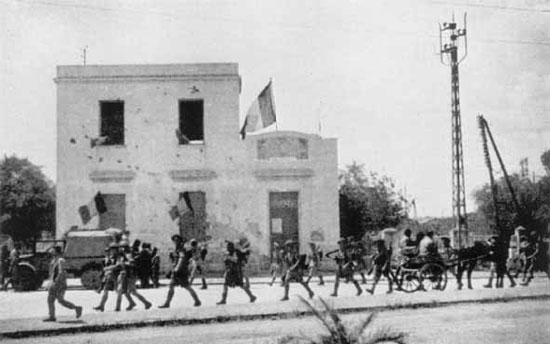Queen's in the Middle East
The Last Act The Capture Of Tunis
Chapter 5
On May Day 1943 the Queen’s Brigade of the 7th Armoured Division set off at 5.45am for a concentration area at Le Krib. The Division had been transferred to IX Corps, under the newly appointed Lieut-General Horrocks. They had orders to paint their transport dark green and cover the Desert Rat signs with grease. Here they spent three pleasant days, amidst green mountains and fields of scarlet poppies. The officers carried out reconnaissances and got to know the new front, while the men carried out some training and rested. Water was plentiful, a welcome experience, and the NAAFI supplies, especially the English cigarettes, seemed unbelievable after the austerity of the Eighth Army. On discovering the contents of the Compo ration, another somewhat arrogant Eighth Army joke was born, on the lines of “.... the First Army, no wonder they can’t fight. They’re too well fed.” Footballs were brought out and several matches were played.

A section of 1/7th Queen's out of the line.
With the men fit and rested, and vehicles loaded with 7 days food and water, the Brigade left their concentration area in the early afternoon of the 5th May, and set off on what was to be the last phase of their long trek from El Alamein. At frequent intervals formations of bombers passed overhead; Bostons, Mitchells and Marauders, usually eighteen to a formation, escorted by literally hundreds of Kittyhawks, Spitfires and Hurricanes as fighter cover. Not one enemy aircraft was seen. The route lay through Gafour to the village of El Aroussa, around which the battalions leaguered for the night.
The plan for the capture of Tunis, codenamed Operation Strike, was for the 4th Indian Division and the 4th British Division to make the initial assaults against several hill features on each side of the Medjez-Tunis road, the 4th Indian on the north side and the 4th British on the south, starting at 3am on the 6th May. In close support of each division would be 80 Churchill tanks, which had proved their incredible ability to climb steep slopes on previous occasions during the campaign. Having cleared the enemy from these positions, 7th Armoured Division would drive through 4th Indian down the Tunis road, and 6th Armoured Division, with 201st Guards Brigade under command, would pass through 4th British Division and take the parallel road from Ksar Tyr-Tunis. A subsidiary attack by the 1st Division from the British V Corps, to clear a feature called Bou Aoukaz on the high ground north of Peter’s Corner, which might cause a problem on the left of 6th Armoured’s route, would start the evening before. This subsidiary attack went in at 4.45pm and shortly after midnight Bou Aoukaz was in British hands.
The break-through was achieved by 8.30am behind a terrific bombardment of artillery fire, and the armour moved off, getting well ahead towards Furna and Massicault, with the 5th Royal Tank Regiment on the left and 1st Royal Tank Regiment on 7th Armoured’s right flank in contact with the 26th Armoured Brigade of 6th Armoured. Squadrons of Allied fighters patrolled up and down the battlefield in front of the tanks. Panzergrenadier Regiment 115, who were defending this sector, were so bemused that they put up a surprisingly feeble resistance. The Queen’s Brigade advanced along two axes, with the 1/7th Queen’s split in two columns acting as vanguards on each route, one column under Lt Col Desmond Gordon on the Grich el Oued road, the northern road, with the 1/6th following up, and the other column under the 2i/c, Major Jimmy Sykes-Wright, leading the 1/5th on the right-hand route. The day was fine and hot, and the dust made visual contact between the two columns impossible. By 4pm the 1/5th Queen’s had formed a firm base on some high ground north-west of Furna, and the 1/7th were sent forward to occupy Massicault as another firm base for the armour, which had advanced about five miles beyond. This constituted an advance of 15 miles in one day against prepared positions, an unprecedented achievement in Tunisia.

Operation Strike - The Capture of Tunis.
By midday on the 7th May, in wind and rain, the 1/5th and 1/6th Queen’s had joined the 1/7th in Massicault and St Cyprien, whereupon the 1/7th went forward again to secure Djebel Achour. Again the other two battalions followed up and took over Djebel Achour, leaving the 1/7th Queen’s free to go clear through to Tunis, which had been entered predictably by the 11th Hussars at 3.30pm, just 36 hours after the start of Operation Strike.
The forward sub-units of the 1/7th Queen’s reached the outskirts of Tunis at 5.30pm. They had been placedunder command of the 22nd Armoured Brigade, and Lt Col Gordon was immediately ordered to take over from three armoured patrols of the 1st Royal Tank Regiment, who were held up by snipers and machine-gun posts, and to push forward through the city and cut the coast road to the Cap Bon Peninsula. ‘B’, ‘C’ and ‘D’ Companies were accordingly sent forward into the city, the first Allied infantry to enter Tunis. The fourth company was held in reserve for POW duties.
The entry into the city was bizarre and unforgettable. Despite the pouring rain, dense crowds of almost hysterical French men and women thronged the streets, threw flowers, clambered on to the vehicles, and offered wine to the troops; all this amidst the smoke and flames of burning vehicles and buildings, with the noise of rifle and machine-guns from the enemy posts that were still holding out. By 6.30pm the companies had reached their allotted areas and the process of winkling out the snipers began. The 6pdr anti-tank guns were brought up and used to great effect.
The area allocated to Stuart Playfoot’s ‘B’ Company in the city centre was the most difficult to control, with its dense crowds of revellers, and the tall buildings giving the snipers excellent fields of fire; not helped by some of the soldiers finding themselves embraced by enthusiastic women! However, with some assistance from the locals acting as guides, any resistance was quickly dealt with.
Major Bill Griffiths with his ‘C’ Company also found many snipers in the southern outskirts, but 14 Platoon, commanded by Lt R.A. Burton, occupied a large fort filled with arms and ammunition, and which commanded all the surrounding area, so resistance was crushed by last light. The company was then ordered to secure the all important bridge leading to Cap Bon on the main road at the southern end of the city. Luckily they found a French policeman to act as a guide and reached the bridge at about midnight, to find it heavily guarded by the enemy, who occupied all the vantage points around it. A confused close-quarter battle then broke out with the use of grenades, sub-machine guns and machine-guns freely exchanged by both sides. The deciding factor was an attached troop of the 260th Anti-Tank Battery, RA, which successfully came into action and systematically demolished the buildings containing the enemy posts. By l.00am the bridge was captured. It was found to be prepared for demolition, so the charges were swiftly removed.

The 1/7th Queen's entering the outskirts of Tunis.
Meanwhile ‘B’ Company had advanced to the north-western end of the city in order to cut the main road from Tebourba. In the pitch dark, with the bewildering number of roads, this was no easy task, but eventually ‘B’ Company reached its objective, and a steady stream of enemy transport was intercepted throughout the night, The Italians tended to surrender willingly, but many Germans tried to turn round or escape to a flank. The most spirited action of the night occurred when 13 Platoon of ‘C’ Company, under 2/Lt R.J. Ashworth, wiped out a lorry-load of Germans, who showed fight, with a most efficiently delivered concentration of fire. By dawn all enemy traffic had ceased. This night’s operations by the two companies of the 1/7th Queen’s was of far-reaching importance to the ending of the campaign, playing a considerable part in bringing about the breakdown of the whole enemy plan to make a fighting withdrawal to the line Hammam Lif-Enfidaville, covering the Cap Bon Peninsula, where supplies for two months’ further campaigning had been collected.
During the morning of the 8th May the rest of the Queen’s Brigade passed through Manouba and Villa Jacques on the north-west outskirts of Tunis. ‘D’ Company of 1/5th Queen’s was detached as a POW guard, and soon 7,000 prisoners had been collected. It was reported that the enemy were attempting an evacuation at Porto Farina between Bizerta and Tunis, so the bulk of the 7th Armoured Division was diverted north, where the 11th Hussars were patrolling the Protville road. On the 9th May the Brigade, less 1/7th Queen’s, reached Protville, and the French population gave them a warm welcome. The enemy had given up his attempt at evacuation and many prisoners began to stream in. The TCVs of the Brigade were busy all afternoon bringing in prisoners, mostly Germans from the 334th Infantry, 999th and Herman Goering Divisions. There were a few Italians, including 50 Italian sailors. There was no trouble with any of the prisoners, who seemed glad that for them the war was over.
For the Queen’s Brigade the campaign was over too. Half the personnel of the battalions were given a day’s leave in Tunis on the 11th May, and the next day the Brigade moved back to El Aroussa, The remaining 50% took their leave in Tunis on the 13th May, all Allied troops being given an unforgettable welcome by the civilian population. On the 15th May the Divisional Commander inspected the Brigade and presented medals to those already gazetted. A guard of ten men from each company paraded, and Major-General Erskine expressed his admiration at their splendid turn-out so soon after the campaign. He read out several letters of congratulation that had been sent to the Division, including a letter from General Montgomery. On the 16th there was a full Church Parade attended by the Brigade Commander. On the 19th May the Brigade commenced its return to Homs, about 60 miles east of Tripoli.
Perhaps the most gratifying message to be received was from the Brigade Commander, Brigadier L.G. Whistler, popularly known by all ranks as ‘Bolo’, who sent out the following letter to all his units:-
H.Q. QUEEN’S BRIGADE
M.E.F.
10th MAY 1943
TO: QUEEN’S BRIGADE To have marched with the EIGHTH ARMY and fought in the 44th and 7th ARMOURED DIVISIONS, and to have come through from EL ALAMEIN to TUNIS is something to remember forever. I could not have imagined a finer and more willing command than this Brigade, which has done more continuous fighting than any other in the EIGHTH ARMY. We of the QUEEN’S BRIGADE fully realise that we could not have done this without the help of those supporting arms which have from time to time so splendidly helped us. I thank you for your great work. |
(Author’s note - The supporting arms were the 5th Regiment, Royal Horse Artillery, the machine-gun companies of the 1st Bn, The Royal Northumberland Fusiliers, and the 69th Medium Regiment RA).
« Previous ![]() Back to List
Back to List ![]() Next »
Next »
Related
